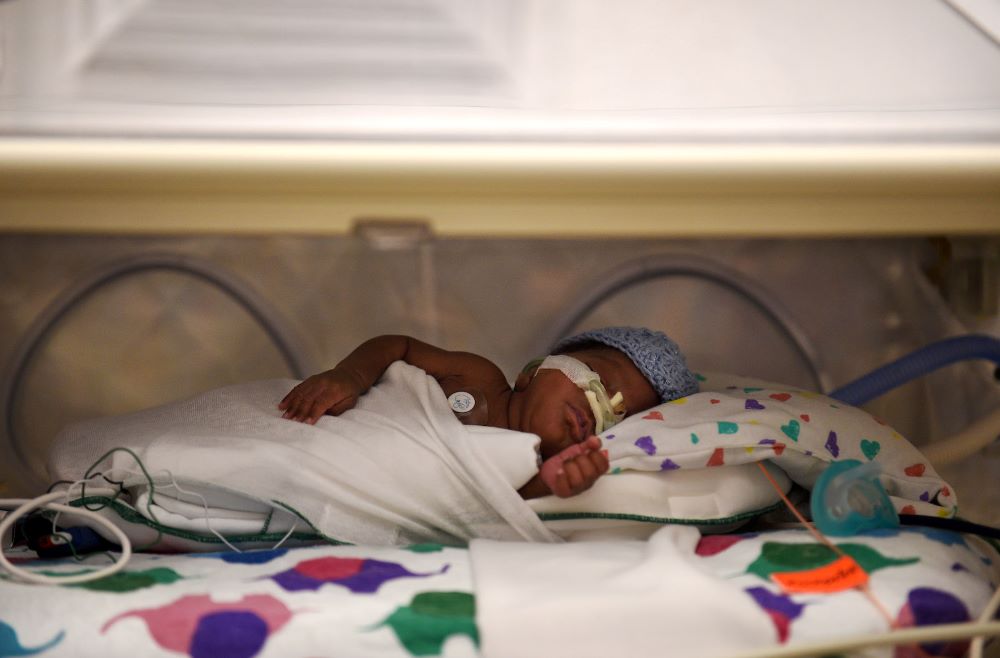
Breast milk is fed via tubes to a preterm infant at a neonatal intensive care unit in Washington, D.C., in 2017. (Grist/The Washington Post via Getty Images/Astrid Riecken)
When Rupa Basu was pregnant with her second child, her body temperature felt out of control — particularly as her third trimester began in the summer of 2007. It wasn't particularly hot in Oakland, California, with high temperatures reaching 80 degrees Fahrenheit. Still, she felt uncomfortably warm even as her colleagues and friends were unbothered.
As her October due date approached, she drank extra fluids and avoided going outside during the hottest stretch of the day. "This is really weird," she recalls thinking. She wondered if there could be a biological mechanism at work.
That notion had troubling implications. "If this is a biological response, imagine what's happening in places like India and Africa where the heat can get to an unbearable 130 degrees Fahrenheit," Basu remembers thinking. As a researcher at the California Environmental Protection Agency's Office of Environmental Health Hazard Assessment, Basu knew that other vulnerable populations, notably the elderly, were particularly susceptible to heat.
But she couldn't find any answers to one fundamental question: do higher temperatures lead to premature births or other pregnancy complications?
Rupa Basu poses for a photo while pregnant with her second child in June 2007. (Grist/Courtesy of Rupa Basu)
As Basu prepared for her second baby's delivery, she began gathering state weather data and birth records to identify preterm births, those that occur prior to 37 weeks of gestation. Preterm birth is linked to a wide variety of health conditions, including anemia, respiratory distress, jaundice, sepsis, and retinopathy — and, at worst, infant mortality.
Researchers, including Basu, had already documented the impacts of air pollution on adverse pregnancy outcomes. But heat was, at the time, uncharted terrain — and the suggestion that it might have an effect was met with skepticism. Colleagues, particularly those who had not ever been pregnant, implied she was wasting her time. But when Basu published her study, her findings spurred similar research all over the world.
Basu analyzed 60,000 summertime births — those taking place between May and September — from 1999 to 2006, across 16 California counties. She found higher rates of preterm births during higher temperatures. She published the research in 2010, and even though she focused on California, it was the first large-scale epidemiological study looking at preterm delivery and temperature conducted anywhere in the world.
What was especially shocking, Basu said, was how much greater the risk was for Black mothers — 2.5 times higher than for white populations.
"How did we miss this for so long?" Basu asked. "Women are often the last to get studied. But the most vulnerable people are those who are pregnant."
Those vulnerabilities are intensifying. In the last year, the hottest on record, 6.3 billion people — notably in South and East Asia and the African Sahel — experienced at least 31 days of extreme heat, hotter than 90 percent of documented temperatures between 1991 and 2020, according to a new report.
As human-caused climate change continues, the number, intensity and duration of heat waves will only get worse. Without intervention, those heat waves will cause millions of babies around the world to be born preterm. Higher temperatures will also have knock-on impacts to gestational and fetal health. As temperatures rise, so does drought and air pollution, which also increases the risk of preterm birth or low birthweight babies. Pollutants from vehicle combustion, including nitrogen oxides and volatile organic compounds, react in sunlight to form ozone. And the U.S. Environmental Protection Agency calculated that extreme heat events will also lead to more wildfires, leading to air pollution that is expected to cause thousands of additional preterm births.
Basu began research on pregnant people because they are woefully understudied and they represent one of the most vulnerable populations. Now that there is strong evidence that heat exacerbates adverse birth outcomes, she hopes it will instigate policy change, promote awareness, and ultimately, decrease risk and disparities. "We need to take more action," she said. "This is preventable."
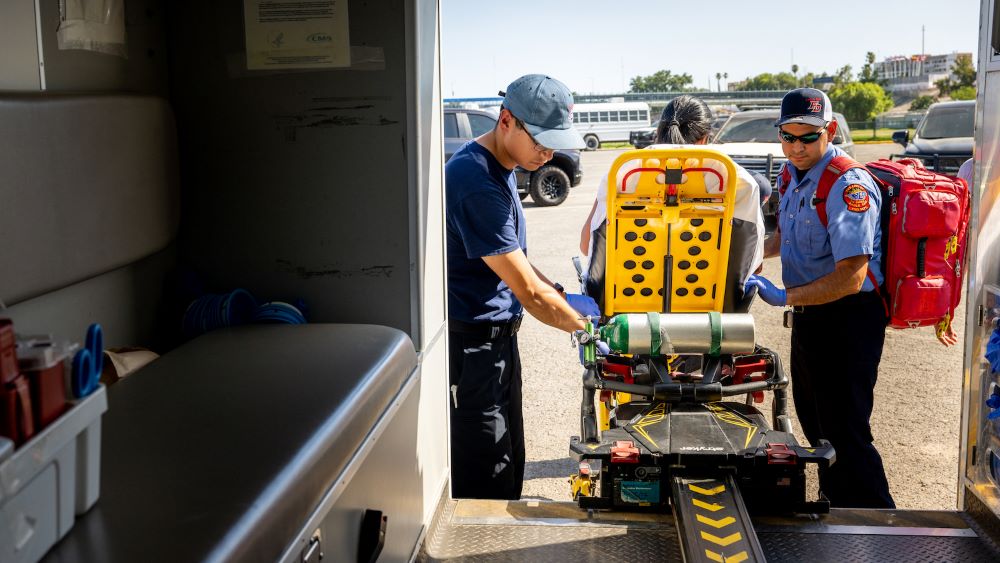
Emergency medical technicians respond to a pregnant woman suffering from dehydration in July 2023 in Eagle Pass, Texas. Grist/Getty Images/Brandon Bell)
In the 14 years since Basu's initial paper, dozens of studies have confirmed that higher temperatures and heat waves are linked to preterm birth as well as stillbirth.
In 2020, Basu co-authored a review of 57 studies that found a significant association between air pollution and heat exposure with preterm birth and low birth weight. Scientists have found an association between heat exposure and preterm birth rates in every developed nation, and in the few developing nations to conduct studies so far.
While it's not yet clear how heat triggers preterm birth, there are several hypotheses — including dehydration, hormonal releases that rupture membranes surrounding the fetus, or poor blood flow between parent and unborn child.
This research has taken place against a backdrop of a worsening maternal health crisis in the U.S., particularly in marginalized communities. The U.S. has the highest rate of preterm births in the developed world. Kasey Rivas, associate director of strategic partnerships at the March of Dimes and a co-author of a recent report on birth outcomes and disparities, told me that maternal health disparities in the U.S. stem largely from systemic racism and are worsening due to climate change.
Advertisement
A 2023 study found that the average preterm birth rate was 7.9 percent across North America, Australia, New Zealand, and Europe in 2020; but the United States' preterm birth rate was higher — 10 percent. By comparison, the highest population-wide preterm birth rate in the world is 13.2 percent in South Asia. U.S. rates of preterm birth increased 4 percent between 2020 and 2021 — and rates were far higher in Black women (14.8 percent) compared to white women (9.5 percent), according to the March of Dimes report. "The data were disturbing and disheartening," Rivas said.
In 2023, a team of scientists decided to take a closer look at a notoriously deadly heat wave in Chicago in 1995 during which over 700 died as high humidity made 106 degrees feel like a hellish 120. "If we didn't see a racial effect during this event, we won't see it anywhere," study co-author Joan Casey, an environmental epidemiologist at the University of Washington in Seattle, recently told me.
Casey and her colleagues found convincingly stark racial disparities. The mean monthly incidence of preterm birth rose 16.7 percent beyond what was expected for Black mothers six months after the heat wave. No such link was seen in non-Hispanic white births.
Further, a study conducted in Harris County, Texas, which includes Houston, the fourth largest U.S. city, found that the risk of preterm birth was 15 percent higher following extremely hot days — and had the greatest impact on communities of color that lived in neighborhoods with more concrete than trees.
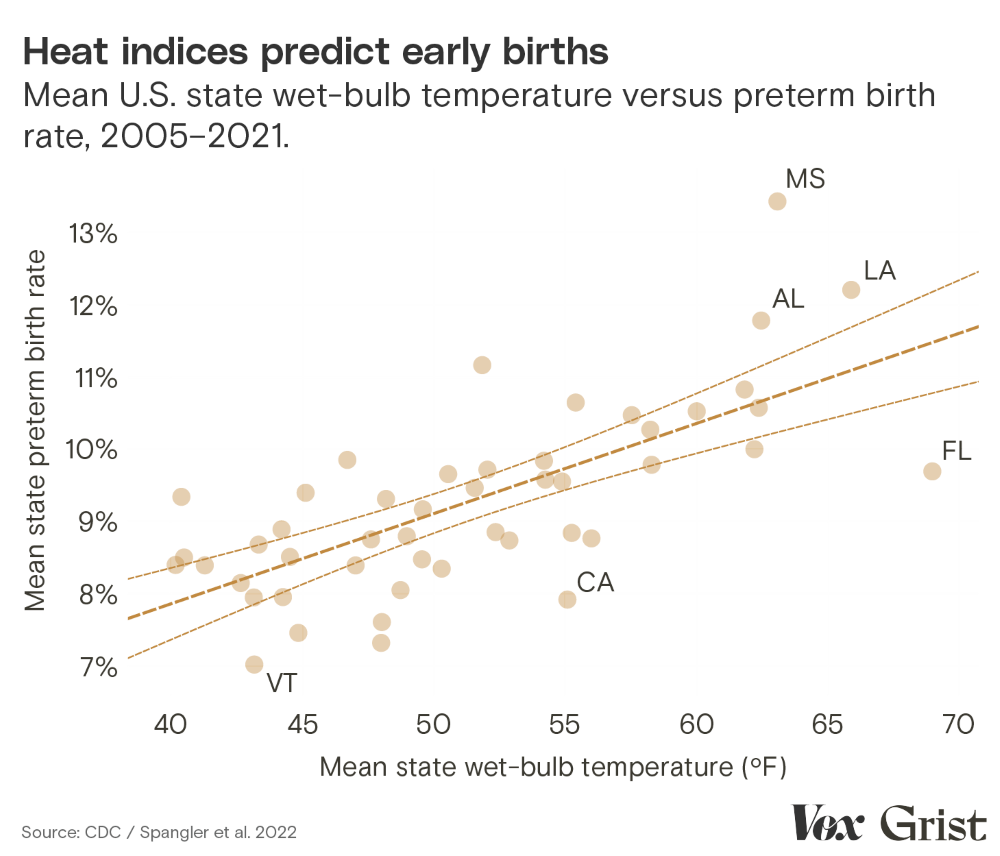
(Grist/Clayton Aldern)
That finding points to the reasons behind the racial gap in preterm births linked to heat waves. Preterm birth has been linked to a number of factors including inadequate nutrition, exposure to air pollution, lack of access to quality health care, lack of air conditioning, or having a job working outdoors — or several of these at once. Heat only worsens existing risks.
And communities of color are more likely than white communities to face all of these risk factors, including heat. Predominantly Black neighborhoods were redlined, or deemed most risky, beginning in the 1930s when insurance companies created maps assigning investment risk levels based on race. Today, those redlined areas have more industrial facilities, excessive truck traffic, and a heavier pollution burden — and often, the least shade or green space. Areas dominated by concrete, asphalt, and buildings experience hotter temperatures due to the urban heat island effect, the phenomenon in which gray infrastructure absorbs and holds more heat than forests or waterways.
Fresno County, California, which has some of the worst air pollution in the United States, exemplifies this pattern. Venise Curry, a consultant for community-based organizations collaborating with the UC San Francisco California Preterm Birth Initiative and others on a prenatal research study designed to lower preterm birth rates, told me that the county's highest preterm birth numbers are in Southwest Fresno — a formerly redlined, predominantly Black neighborhood of color.
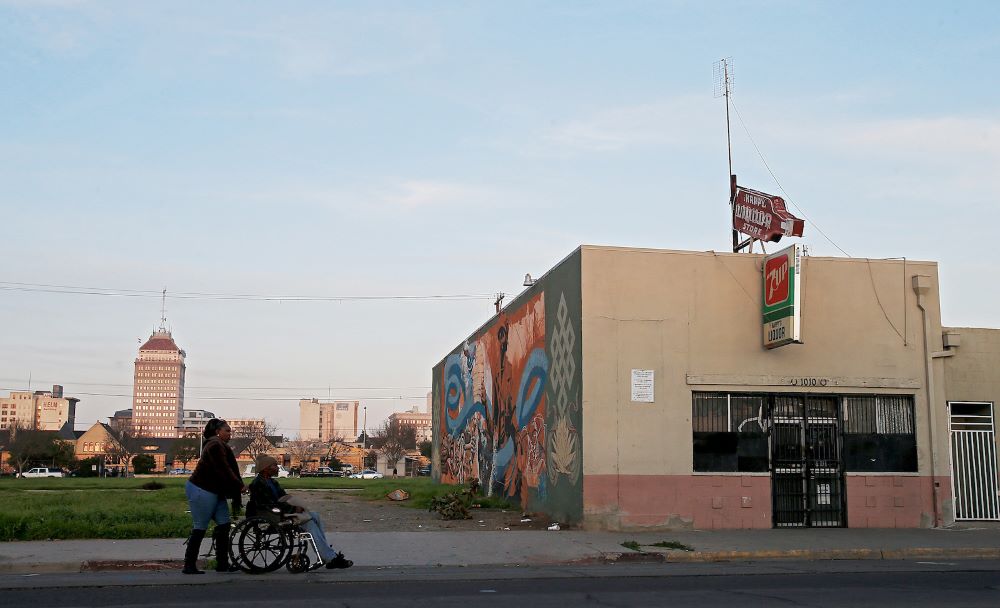
Shuttered storefronts line the area west of downtown Fresno, a city with a long history of redlining, or institutionalized housing racism. (Grist/Los Angeles Times via Getty Images/Luis Sinco)
Black and white "women experience broadly similar climate changes, but are seeing drastically different outcomes — so something else must be at play," said Bryttani Wooten, a Ph.D. student at the University of North Carolina at Chapel Hill who has studied racial disparities in preterm birth rates. "That something else is systemic racism, including legacies of residential segregation."
Obstetric providers in low-income communities of color describe preterm birth as a crisis. "Preterm birth is a 24/7, 365-days-a-year public health emergency in my community," said Nneoma Nwachuku Ojiaku, an obstetrician in Sacramento. Madeleine Wisner, who was the only midwife provider serving low-income residents in the Sacramento Valley through the state Medicaid program for seven years until recently, described something similar. "A course of maternity care where nothing abnormal happens doesn't exist any longer in the populations I was serving," Wisner said. She's seen a range of birth complications — including abnormally implanted placentas, umbilical cord abnormalities, and preeclampsia — in patients who were exposed to heat, air pollution, or wildfire smoke during pregnancy.
Black doulas and midwives are a small but growing population determined to improve Black maternal health, said Maya Jackson, the founder of Mobilizing African American Mothers through Empowerment, or MAAME. She said that while Black midwives were once at the forefront of birthing health care for Black and white mothers post-slavery, their systematic exclusion from medical institutions changed that. Today, Jackson is seeking funding to do community-based research on heat impacts on people of color to make sure that their lived experiences and the impacts of policies that shape housing, green spaces, or industrial pollution in brown and black neighborhoods are documented.
"Somehow living has become a political issue," she said.
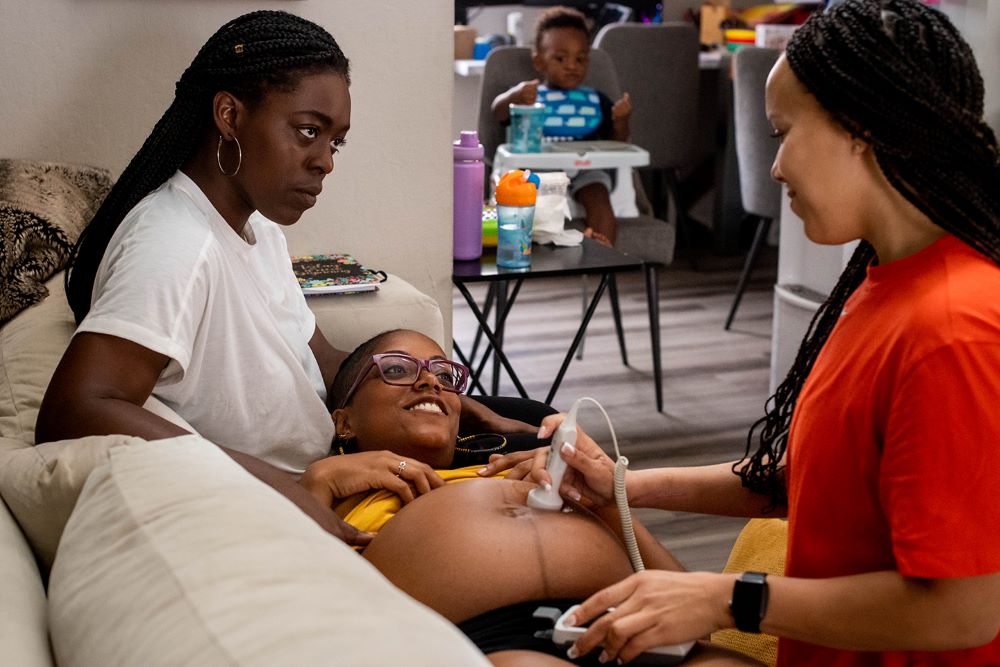
A midwife talks with a woman and her pregnant wife in their home in Fountain Valley, California, in June 2021. In an effort to avoid racism and higher maternal mortality rates, some Black women are turning to Black midwives for care. (Grist/MediaNews Group/Los Angeles Daily News via Getty Images/Sarah Reingewirtz)
In recent years, researchers have turned their attention to poorer, hotter regions of the world — and the findings are grim. In March, a study conducted among outdoor workers in India found that exposure to heat stress above 81 degrees F doubled the risk of miscarriage. Overall in India, 8.5 percent of pregnancies in urban areas and 6.9 percent in rural areas end in miscarriage.
Ana Bonell, a researcher at the London School of Hygiene and Tropical Medicine, studies heat and birth outcomes in western Africa and Pakistan. She said it's difficult to conduct research on maternal climate exposure and adverse birth outcomes in most places in Africa because they often don't have electronic health records or the equipment needed to accurately determine how far along a pregnancy is — information necessary to determine if a birth is, in fact, preterm.
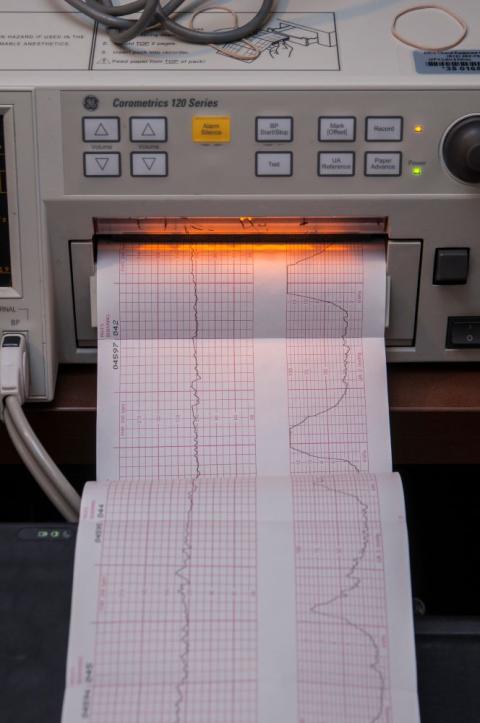
A fetal monitor checks the maternal vital signs of a woman getting ready to have a baby. (Grist/Education Images/Universal Images Group via Getty Images)
Instead, she looked at acute physiological changes in pregnant farmworkers and their fetuses in The Gambia, a country in West Africa where the average temperature is 83 degrees F. In 2022, she published data showing that the farmworkers exhibited a 17 percent increase in fetal stress, defined by a fetal heart rate either above 160 or below 115 beats per minute or decreased placental blood flow, for each degree Celsius of heat.
"[These are] populations that have contributed almost nothing to climate change and are at [the] front lines of the climate crisis," Bonell said. Research in Ghana, published last year, also found that exposure to temperatures 87 degrees F or higher throughout a pregnancy resulted in an 18 percent increased risk of stillbirth.
"There seems to be this myth of endless adaptation," said Chandni Singh, a climate researcher at the Indian Institute for Human Settlements. "In tropical countries that are already very hot, there is this continuous expectation to adapt, which is not feasible. You can't adapt to 45 C" (113 degrees F). And heat has knock-on impacts. "Heat doesn't come alone; it comes with water scarcity and wildfires," she said, emphasizing the need to curtail greenhouse gas emissions.
Singh has reviewed a number of heat action plans created by city and state governments globally to improve heat advisory messaging or build cooling spaces and environments. She said there is an increasing but still insufficient focus on women, particularly addressing the fact that people who are pregnant or lactating have unique heat adaptation needs.
"We know this is a problem, and certain women are affected more," said Singh. "How do we deal with that? That's the next challenge."
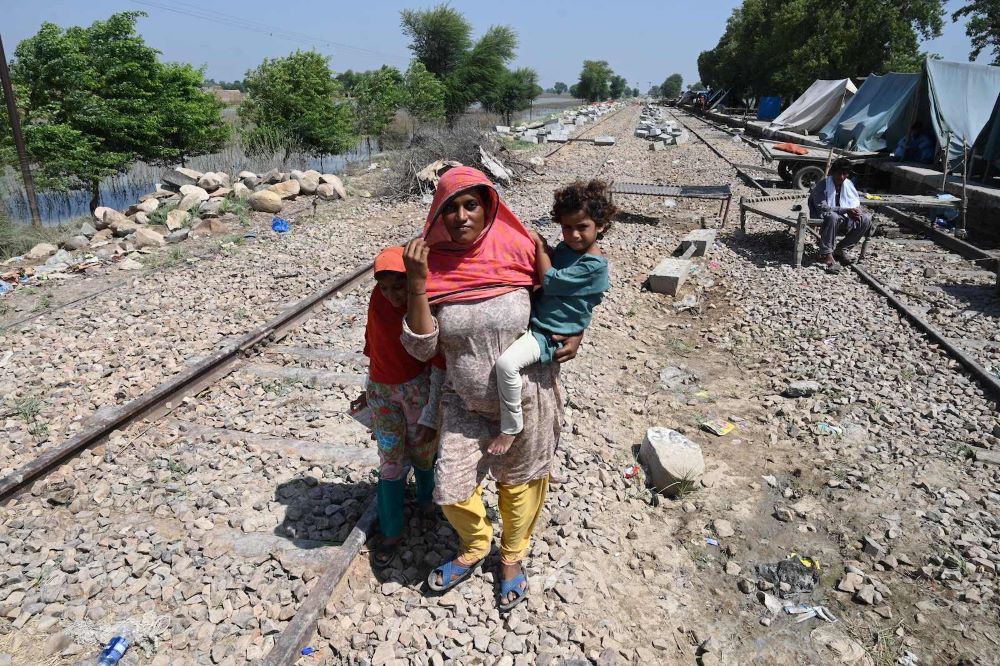
A pregnant flood-affected woman carries her child as she walks near her tent at a makeshift camp along a railway track in India’s Punjab province in September 2022. (Grist/AFP via Getty Images/Arif Ali)
While research has established the link between heat and preterm birth, the next steps are to figure out how it happens in the body, and more importantly, how to prevent it.
On an individual level, Ojiaku advises her patients, as early as possible in their pregnancies, to keep cool, stay hydrated, and limit work-related heat exposures as much as possible.
But other policies are needed to right racial inequities. In 2022, Ojiaku called on Sacramento leaders to improve public health messaging about heat risks — and to appoint a chief heat officer, akin to those in Los Angeles, Phoenix, and Miami, whose job it would be to include pregnant people as at-risk populations in heat advisories.
A March study of 17 federal, 38 state, and 19 city websites with heat-health information found that only seven websites listed pregnant people as vulnerable or at-risk populations.
"We are more likely to see information on how to take care of pets during heat waves than pregnant women," Ojiaku told me.
In addition, she said, creating green spaces such as parks in neighborhoods that have been subject to systemic racism and redlining can offer shade, cool spaces to exercise, and a buffer against air pollution.
"Sacramento is called 'the city of trees,' but that's for a select few in the predominantly wealthier sections of Sacramento," Ojiaku said. "Other areas are a concrete jungle."
In 2023, UNICEF, the United Nations Children's Fund, published a dossier describing measures needed to protect women and children from heat waves. It stressed prevention and preparedness, including training frontline workers to identify heat-related illness and local government adaptations such as providing cooling centers and shaded areas.
"We need to get prepared and take heat waves just as seriously as other disasters," Ojiaku said.








